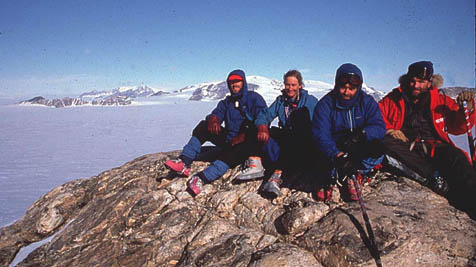International Antarctic Conference at UCSB
The Cold Truth

Hiding out on the bottom of the world, Antarctica has long lived in the far recesses of public interest-garnering rare attention for its radical weather patterns, penguin occupants, and occasional exploratory tragedy. However, the continent’s relative anonymity has changed in recent years, and the ever-increasing and irrefutable realities of global warming have helped the world’s fifth-largest continent surge to the frontlines of public discourse on climate change.
A site of international scientific research since the late 1950s, Antarctica-with its 14-million-plus square kilometers of ice-has emerged as the ultimate tool for understanding both historic and future global climate trends. Its frozen landscape provides a perfectly preserved tomb for millions of years’ worth of data about weather patterns and greenhouse gases. This week, with the climate change debate locked dead in their collective sites, more than 400 scientists coming from more than 35 different countries have gathered at UCSB for the International Symposium on Antarctic Earth Science (ISAES). And, judging from some of their findings, the more we learn about Antarctica, the direr our situation appears to be.
Taking place on U.S. soil for the first time since 1973, the ISAES is the ultimate show-and-tell forum for all things Antarctica. It provides a place for the scientific community to share information, strategize with researchers, and, perhaps most importantly, provide a means of influencing policymakers from around the world to make more environmentally conscious decisions. Themed Antarctica: A Keystone in a Changing World, the 2007 ISAES is chockfull of findings that not only paint a bleak picture we can’t afford to ignore but also provide indirect glimmers of hope as researchers appear to be cracking the code of Antarctica’s role in the world’s climate shift. With presentations on such subjects as unfrozen lakes miles beneath the ice sheet, historic greenhouse gas levels from the past million years, 35-million-year-old tectonic plate patterns and the impact they have on global weather trends, and 100 million years of Antarctic climate evolution as seen through plant fossils, the conference is proof that you cannot understand your future if you don’t know your past. As UCSB geology professor and veteran Antarctic researcher Bruce Luyendyk put it recently, “To make predictions about how our global climate is going to evolve-which is something we all should care about by now-you have to know its historical behavior. And it is pretty clear the poles, especially the Antarctic, are the most crucial climate regulators on the planet today.”
While all of the aforementioned presentations are key ingredients in understanding the nature of Antarctica’s role in the world’s climate, perhaps the most significant of the five-day conference-at least in terms of opening the public’s eyes-came from University of Copenhagen professor Dorte Dahl-Jensen. Extrapolating on data made famous in Al Gore’s An Inconvenient Truth, Dahl-Jensen’s keynote presentation focused on insights into global climate change as evidenced by core samples taken from the vast expanses of ice that comprise more than 98 percent of Antarctica’s territory. Drilling down and getting samples of perfectly preserved ancient air, Dahl-Jensen is able to provide hard numbers for greenhouse gas concentrations from as far back as one million years ago. And when those numbers are compared to the greenhouse levels of today, the prognosis isn’t pretty. According to her data, the levels of greenhouse gases currently found in the Antarctic are at least two times higher than they have ever been before. As Luyendyk points out, the juxtaposition of the two is a deal breaker in the climate change argument. “Those numbers are the real clincher. It’s hard to argue against stuff like that,” he said.
4•1•1
The International Symposium on Antarctic Earth Science will take place through Saturday, September 1, at UCSB. Visit isaes2007.geol.ucsb.edu for details and schedules.



